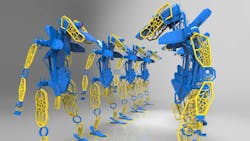Emerging technology takes time to become mainstream in the manufacturing industry. Raised on traditional processes and tried-and-true methodologies, designers tend to forego advantageous moves to new platforms. When the opportunity arises to reduce manufacturing costs, increase productivity, and improve product design however, its imperative manufacturers take note and learn to adapt.
Generative Design may seem like an abstract concept and difficult to onboard, but much like CAD software introduced digital tools to make it easier to draw and revise parts, Generative Design technology introduces ways to improve and accelerate the design process.
Most misconceptions about Generative Design include the impression that it is complex or the idea that it will replace engineers and designers. In actuality, Generative Design provides a way for engineers to quickly explore various design alternatives that enhance and augment existing work processes.
To best understand how Generative Design fits into the product lifecycle one can look at a 7-step structure: Ask and Research, Imagine and Plan, Create and Test, and Improve.
Ask and Research:
As with any design, the “ask and research” phase is critical. Without a clear understanding and specificity of the project constraints, the work can fail before it even begins. Whether designing a new part or reimagining an existing one, Generative Design requires an intimate knowledge of the part, its use, and its interactions with other parts.
The first step in Generative Design is to develop the foundational model for the software. This model includes the base geometry and constraints the program needs to develop its own designs. While this can seem confusing or overwhelming, it uses similar tools to other 3D modeling software. The engineer inputs information on necessary geometry and obstructions for mounting and interactions with other parts, load conditions, manufacturing requirements, material, a minimum accepted factor of safety, and other data to guide the design.
Imagine and Plan:
Once the design criteria is set, Generative Design does its part refining the model using algorithms to optimize the design. This could mean reducing material usage or maximizing strength while maintaining the weight of the original part. This process allows engineers to quickly develop a series of unique models and directly compare them by weight, volume, material, sustainability, machine time, cost, and more.
As with any design, this process isn’t guaranteed to result in the perfect design on the first try. The key to Generative Design is speed and diversity. While it may take several iterations and changes to the initial conditions to land on the best design, Generative Design provides the ability to quickly explore varied avenues. It can run assorted materials or manufacturing options side-by-side, potentially eliminating weeks of work exploring a wrong path.
Create and Test:
While traditional prototyping is an option, computer modeling and simulation can quickly validate results. The output from the Generative Design tool provides both a 3D model and Finite Element Analysis (FEA) simulations for all input load conditions. This allows for rapid prototyping and further comparison and validation of designs.
It is important to also assess the manufacturability at this point. While there are settings to select manufacturing methods, tool settings, and minimal part thicknesses, it is still possible for the design to be inefficient or outside the scope of existing manufacturing capabilities. The software can also generate a cost analysis based on material use and manufacturing methods or simulate a tool path to determine machine time.
Improve:
It is this step in the design process that has caused the most confusion and misconceptions surrounding Generative Design. For some industries, this step can be skipped or significantly reduced as they have the technology to manufacture complete models generated by a computer. For most manufacturers, however, this would be the time to simplify the design and adapt manufacturability to available machinery.
Using the generated model, the FEA results, and manufacturing analysis, engineers can interpret the results and modify them to capture the design intent in a more manufacturable manner. By using techniques like consolidating and standardizing limbs, creating flat surfaces or standard fillets, and reinforcing connection points, engineers can craft a final product that revolutionizes the design without the need for expensive new equipment.
Another, more accessible, example of generative design is a case study of an elevator door drive wheel wherein the process helped to literally reinvent the wheel. The original carbon steel part was cut down to the sleeker aluminum design using Autodesk Fusion 360. While this new design boasted over 30% material reduction by volume and over 75% reduction by weight, it was deemed unsuitable for manufacturing.
However, by modifying the new design (removing thin and unwanted geometry, flattening surfaces, re-establishing symmetry, and strengthening the central connections) the final model had comparable machine time to the original by 3-axis milling or reduced lead time by casting while remaining within 2% of the volume and weight reduction achieved by the generative design.
Sustainable Manufacturing
Generative Design is still a new technology in the manufacturing world and is constantly improving and evolving. It isn’t a substitute for engineers but rather a tool for them to elevate their designs. Once they’re able to look past the preconceived notions about Generative Design, they’ll see that the benefits are well worth the effort.
The first thing any company will appreciate is the savings on part production, as reduced material use not only saves the cost of the raw material but also shipping expenses. The redesigns can also lead to reduced machine times and quicker time to market. Most importantly all of these factors contribute to a more sustainable manufacturing process.
About the Author

Tristan Gunderson
Application Engineer, M2Technologies
As an Applications Engineer at M2 Technologies, Tristan Gunderson provides support and consulting services to help customers optimize their software utilization and design processes. He works to promote sustainable and efficient manufacturing through the implementation of simulation and generative design.


